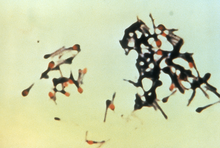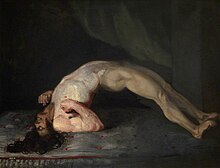破傷風梭菌
| 破傷風梭菌 | |
|---|---|

| |
| 顯微鏡下呈典型“網球拍”形狀的破傷風梭菌 | |
| 科学分类 | |
| 域: | 细菌域 Bacteria |
| 界: | 细菌界 Bacteria |
| 门: | 厚壁菌门 Firmicutes |
| 纲: | 梭菌綱 Clostridia |
| 目: | 梭菌目 Clostridiales |
| 科: | 梭菌科 Clostridiaceae |
| 属: | 梭菌屬 Clostridium |
| 种: | 破傷風梭菌 C. tetani
|
| 二名法 | |
| Clostridium tetani (Flügge 1886) Bergey et al. 1923
| |
| 模式菌株 | |
| ATCC 19406 = CCUG 4220 = NCTC 279 | |
破傷風梭菌(學名:Clostridium tetani)是一種常見的梭菌屬杆狀專性厭氧菌,外觀類似網球拍和雞腿[1],是破傷風的病原體。若進入到傷口深處,則會滋生並產生劇毒,稱為破傷風痙攣毒素,干擾運動神經元,造成破傷風。破傷風類毒素疫苗能夠阻礙該毒素作用,各地常為兒童接種,以作預防。
破傷風梭菌通常有0.5μm寬和2.5μm長。[2]
破傷風梭菌雖不能生長在有氧氣的情況下[2],其孢子耐受力強,可於世界各地土壤或動物消化道找到。生活並分佈在世界各地的土壤中以及各種牲畜和伴侶動物的腸道中[3]。且在33至37°C的溫度範圍內生長最好。[2]
特徵

各種條件下,破傷風梭菌都會脫落鞭毛形成內生孢子。每個破傷風梭菌都可以形成孢子,一般孢子形成在破傷風梭菌的一端,形成鼓槌的形狀[2]。
演化
破傷風梭菌屬於梭菌屬,而梭菌屬是一個廣泛的組群,包含百多種革蘭氏陽性細菌。其中近百個物種,又比任何其他從基因上更密切。該集群包括肉毒梭菌和產氣莢膜梭菌。與破傷風梭菌最近的近親是梭狀芽孢桿菌[3]。
疾病

雖然破傷風梭菌在土壤或動物腸道中大多是良性,但有時依然會導致嚴重的破傷風。疾病通常始於孢子通過傷口進入人體[5]。深傷口中,例如被鐵釘頂穿大腿,壞死組織和低氧環境,會使破傷風梭菌孢子發芽[4]。當破傷風梭菌在傷口部位生長時,會滋生並產生劇毒外毒素、tetanolysin和破傷風痙攣毒素,干擾運動神經元,造成破傷風。tetanolysin的功能尚不清楚,它可能有助於破傷風梭菌感染。破傷風痙攣毒素是已知最有效的毒素之一,估計致死劑量低於每公斤體重2.5納克,是造成破傷風症狀的原因[2][6]。
破傷風梭菌通過淋巴系統和血液傳播,並被吸收到神經系統的各個部分[6]。
在神經系統中,破傷風梭菌阻斷運動神經末梢的抑制神經遞質甘氨酸和γ-氨基丁酸的釋放。這種封鎖導致運動神經元廣泛激活而全身痙攣。肌肉痙攣通常從身體頂部開始並向下移動,先感染頜,然後腹部肌肉,再然後是四肢。肌肉痙攣會持續數週[5][6]。
在許多破傷風梭菌菌株攜帶的質粒上發現了編碼破傷風痙攣的基因;缺乏該質粒的菌株不產生毒素[2][5]。破傷風痙攣在細菌生理學中的作用是未知的[2]。
治療和預防
許多抗生素對破傷風梭菌有效,包括氯黴素、克林黴素、紅黴素、青黴素和四環素[3]。然而,用抗生素治療破傷風梭菌感染的有效性仍不清楚。[2]
破傷風梭菌感染造成的損害通常由甲醛滅活的破傷風疫苗來預防。疫苗的商業生產方式是大量種植破傷風梭菌,然後純化毒素並在40%甲醛中滅活4至6週的[2]。通常與白喉類疫苗和某種形式的百日咳疫苗合為DPT疫苗或DTaP。疫苗會分開數次施打,每針之間相隔數月或數年,以引發免疫反應,保護宿主免受毒素影響[6]。
研究
破傷風梭菌可在各種厭氧培養基生長,例如巰基乙酸鹽培養基、酪蛋白水解物培養基等。培養物在中性至鹼性pH值的培養基上生長特別好[2]。
歷史
至少早在公元前4世紀希波克拉底就寫了破傷風的臨床描述[8]。不過第一次與土壤明確聯繫是在1884年,1884年普魯士人亞瑟·尼古拉耶發現動物注射土壤樣本的患破傷風[6]。
1889 年,日本醫學家北里柴三郎從人類受害者身上分離出破傷風梭菌,後來證明這種生物體注射到動物體內也會產生疾病,並且毒素可被特定抗體中和[6]。
1897年,法國獸醫埃德蒙·諾卡爾發現破傷風抗毒素可在人體中引起被動免疫,可用於預防和治療[6]。
第一次世界大戰,馬的破傷風抗血清被廣泛用於預防受傷士兵破傷風,所以戰爭期間破傷風病例急劇減少[9]。
用甲醛滅活破傷風毒素的現代方法是由加斯頓·拉蒙在1920年開發的[6]。
很快,1924年P. Descombey開發了破傷風類毒素疫苗,該疫苗被廣泛用於預防二戰期間因戰傷引起的破傷風[6]。
參考文獻
- ^ Ryan, Kenneth J.; Ray, C. George; Sherris, John C. Sherris medical microbiology : an introduction to infectious diseases 4th. New York: McGraw-Hill. 2004. ISBN 0-8385-8529-9. OCLC 52358530.
- ^ 2.00 2.01 2.02 2.03 2.04 2.05 2.06 2.07 2.08 2.09 2.10 Roper, Martha H.; Wassilak, Steven G.F.; Tiwari, Tejpratap S.P.; Orenstein, Walter A. Tetanus toxoid. Vaccines. Elsevier. 2013: 746–772 [2022-11-12]. ISBN 978-1-4557-0090-5. doi:10.1016/b978-1-4557-0090-5.00039-2. (原始内容存档于2021-08-29) (英语).
- ^ 3.0 3.1 3.2 Whitman, William B (编). Bergey's Manual of Systematics of Archaea and Bacteria 1. Wiley. 2015-04-17 [2022-11-12]. ISBN 978-1-118-96060-8. doi:10.1002/9781118960608.gbm00619. (原始内容存档于2020-10-26) (英语).
- ^ 4.0 4.1 Pottinger P, Reller B, Ryan KJ, Weissman S. Chapter 29: Clostridium, Bacteroides, and Other Anaerobes. Ryan KJ (编). Sherris Medical Microbiology 7. McGraw-Hill Education. 2018. ISBN 978-1-259-85980-9.
- ^ 5.0 5.1 5.2 Todar K. Pathogenic Clostridia, including Botulism and Tetanus. Todar's Online Textbook of Bacteriology. 2005: 3 [2022-07-20]. (原始内容存档于2021-05-15).
- ^ 6.0 6.1 6.2 6.3 6.4 6.5 6.6 6.7 6.8 Hamborsky J, Kroger A, Wolfe C (编). Chapter 21: Tetanus. The Pink Book - Epidemiology and Prevention of Vaccine-Preventable Diseases 13. U.S. Centers for Disease Control and Prevention. 2015: 341–352 [24 June 2018]. (原始内容存档于2017-04-13).
- ^ Brüggemann, Holger; Bäumer, Sebastian; Fricke, Wolfgang Florian; Wiezer, Arnim; Liesegang, Heiko; Decker, Iwona; Herzberg, Christina; Martínez-Arias, Rosa; Merkl, Rainer; Henne, Anke; Gottschalk, Gerhard. The genome sequence of Clostridium tetani , the causative agent of tetanus disease. Proceedings of the National Academy of Sciences. 2003-02-04, 100 (3) [2022-11-12]. Bibcode:2003PNAS..100.1316B. ISSN 0027-8424. PMC 298770
 . PMID 12552129. doi:10.1073/pnas.0335853100. (原始内容存档于2022-11-12) (英语).
. PMID 12552129. doi:10.1073/pnas.0335853100. (原始内容存档于2022-11-12) (英语).
- ^ Pearce, J. M. Notes on tetanus (lockjaw).. Journal of Neurology, Neurosurgery & Psychiatry. 1996-03-01, 60 (3) [2022-11-12]. ISSN 0022-3050. PMC 1073859
 . PMID 8609513. doi:10.1136/jnnp.60.3.332. (原始内容存档于2022-11-12) (英语).
. PMID 8609513. doi:10.1136/jnnp.60.3.332. (原始内容存档于2022-11-12) (英语).
- ^ Wever, Peter Cornelis; van Bergen, Leo. Prevention of tetanus during the First World War. Medical Humanities. 2012-12, 38 (2) [2022-11-12]. ISSN 1468-215X. PMID 22543225. S2CID 30610331. doi:10.1136/medhum-2011-010157. hdl:20.500.11755/8e372c60-b6a6-4638-a2ba-664e20b30ad1. (原始内容存档于2022-11-12) (英语).
延伸閱讀
- Clinical Microbiology, ISBN 0-940780-49-6
外部連結
| |||||||||||||||||||||||||||||||||||||||||||||||||||||||||||||||||||||||||||||||||||||||||||||||||||||||||||||
|
Text is available under the CC BY-SA 4.0 license; additional terms may apply.
Images, videos and audio are available under their respective licenses.
